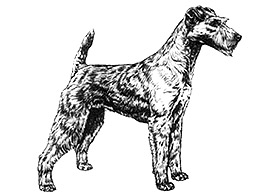Irish Terrier Breed Standard
Last updated: 22 May 2009
A breed standard is the guideline which describes the ideal characteristics, temperament, and appearance of a breed and ensures that the breed is fit for function with soundness essential. Breeders and judges should at all times be mindful of features which could be detrimental in any way to the health, welfare or soundness of this breed.

Kennel Club, London 1994
-
Group:
Group 2 (Terriers)
-
History:
-
General Appearance:
An active, lively and wiry appearance; plenty of substance but free of clumsiness. Neither cloddy nor cobby but showing a graceful racy outline.
-
Characteristics:
There is a heedless, reckless pluck about the Irish Terrier which is characteristic. They develop a great devotion for their masters.
-
Temperament:
Good tempered, notably with humans, it being admitted, however, that he is perhaps a little to ready to resent interference on the part of other dogs.
-
Head And Skull:
Head long; skull flat, and rather narrow between ears, narrowing towards eye; free from wrinkles; stop hardly visible except in profile. Jaw strong and muscular, but not too full in cheek, and of good length. Foreface not dished or falling away quickly between eyes, delicately chiselled. Lips well fitting and externally almost black in colour. Nose black.
-
Eyes:
Dark, small, not prominent. A light or yellow eye highly undesirable.
-
Ears:
Small and V-shaped, of moderate thickness, set well on head, and dropping forward closely to cheek. Top of folded ear well above level of skull. Ear must be free of fringe, and hair thereon shorter and darker in colour than body.
-
Mouth:
Teeth even, strong and free from discolouration. Jaws strong, with perfect, regular scissor bite, i.e. upper teeth closely overlapping the lower teeth and set square to the jaws.
-
Neck:
Fair length and gradually widening towards shoulders, well carried and free of throatiness. Generally a slight fringe at each side of neck, running nearly to corner of ear.
-
Forequarters:
Shoulders fine, long and well laid back. Legs moderately long, well set from shoulders, perfectly straight, with plenty of bone and muscle; elbows working freely clear of sides; pasterns short and straight, hardly noticeable, the forelegs moved straightforward when travelling.
-
Body:
Chest deep and muscular, neither full nor wide. Body moderately long; back strong and straight, with no appearance of slackness behind shoulders; loin muscular and slightly arched; ribs fairly sprung, rather deep than round, and well ribbed back.
-
Hindquarters:
Strong and muscular, thighs powerful, hocks well let down, stifles moderately bent. Hindlegs moved straight forward when travelling, hocks not turned outwards. Hair on legs dense and crisp.
-
Feet:
Strong, tolerably round, moderately small, toes arched, neither turned out nor in; black toe nails most desirable. Pads sound and free from cracks or horny excrescences.
-
Tail:
Docked: Customarily docked to about three quarters [3/4]. Free of fringe or feather, but well covered with rough hair. Set on pretty high, carried gaily, but not over back or curled.
Undocked: Set on pretty high, carried gaily, but no over back or curled. Free of fringe or feather, but well covered with rough hair. In oversall balance with the rest of the dog. Carriage is such that the tail is not liable to damage during working.
-
Gait/Movement:
Fore and hind legs carried straight forward and parallel. Elbows move perpendicular to body, working free of sides, stifles neither turning in nor out.
-
Coat:
Harsh and wiry, having broken appearance, free of softness or silkiness, not so long as to hide the outline of body, particularly in hindquarters, straight and flat, no shagginess and free of lock or curl. At base of these stiff hairs is growth of finer and softer hair, usually termed the undercoat. Hair on foreface crisp and only sufficiently long to impart appearance of additional strength. Hair on legs dense and crisp.
-
Colour:
'Whole-coloured', most preferable colours being red, red wheaten, or yellow red. Small amount of white on chest acceptable, white on feet highly undesirable. Black shading highly undesirable.
-
Sizes:
Ideal height: Dogs 48 cms (19 ins)
Bitches 46 cms (18 ins).
-
Faults:
Any departure from the foregoing points should be considered a fault and the seriousness with which the fault should be regarded should be in exact proportion to its degree and its effect upon the health and welfare of the dog.
-
Notes:
Male animals should have two apparently normal testicles fully descended into the scrotum.
 For owners
For owners
 Members
Members
 Dogs Australia is a not-for-profit organisation advocating for the preservation of purebred dogs through ethical breeding.
It champions the highest standard of animal welfare through education and fostering dog-loving communities.
Internationally recognised and established in 1958 as the Australian National Kennel Council (ANKC),
the organisation promotes responsible dog ownership; maintains the ORCHID* heritable canine diseases database;
funds research into canine diseases; and supports state and territory-based member bodies.
Dogs Australia promotes breed conformation shows and community sports for dogs that fulfil a breed’s natural instincts.
Dogs Australia is a not-for-profit organisation advocating for the preservation of purebred dogs through ethical breeding.
It champions the highest standard of animal welfare through education and fostering dog-loving communities.
Internationally recognised and established in 1958 as the Australian National Kennel Council (ANKC),
the organisation promotes responsible dog ownership; maintains the ORCHID* heritable canine diseases database;
funds research into canine diseases; and supports state and territory-based member bodies.
Dogs Australia promotes breed conformation shows and community sports for dogs that fulfil a breed’s natural instincts.







